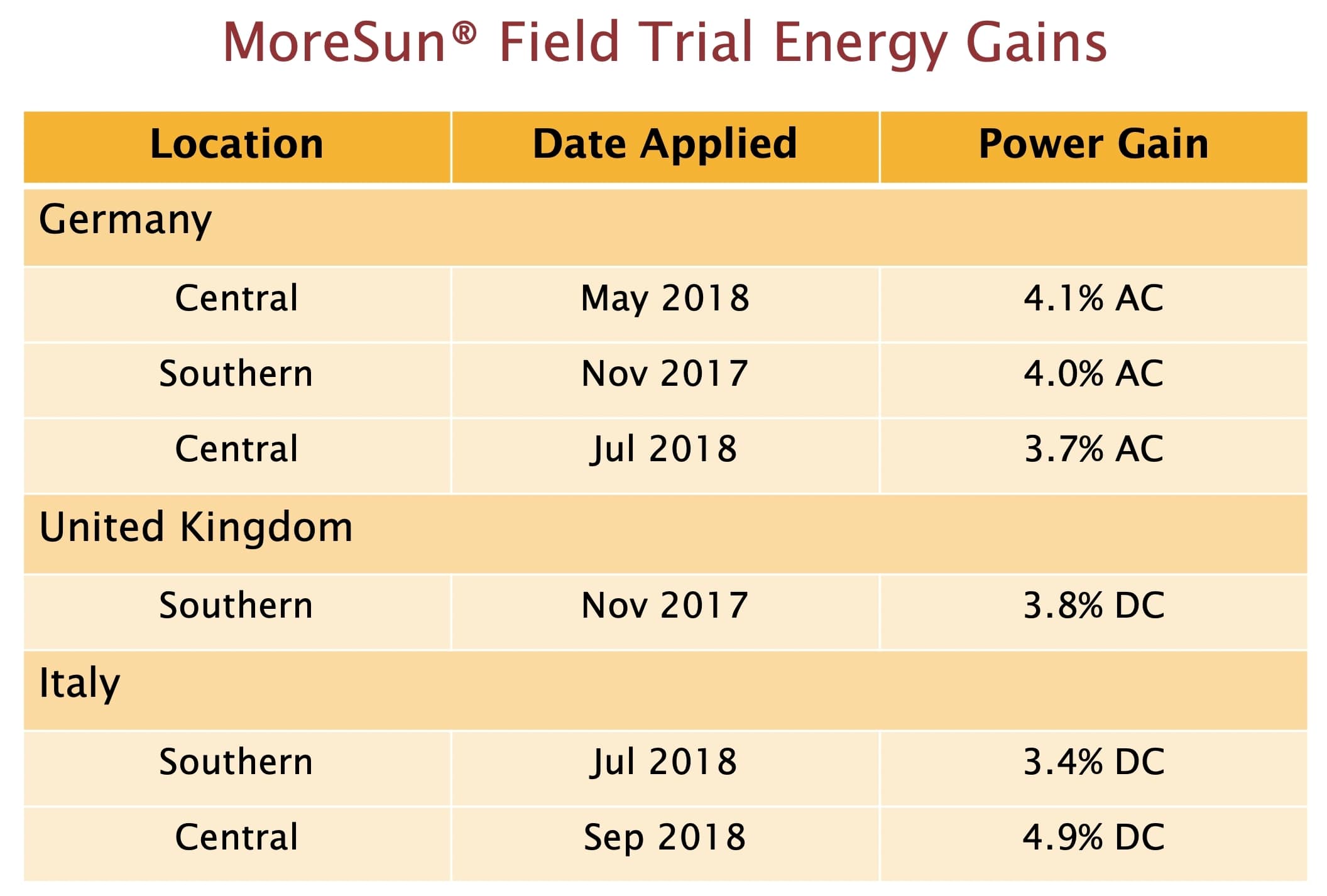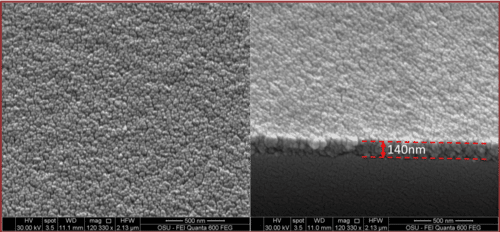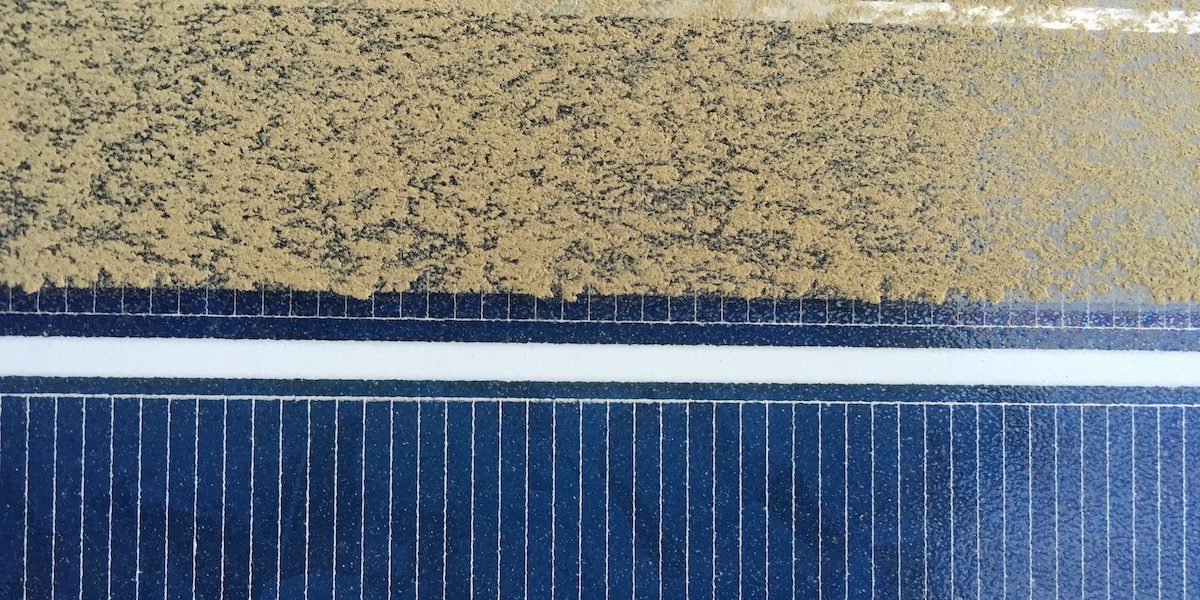Pellucere Technologies announced that it has secured a major investment from Energy Innovation Capital. The investment enables the beginning of “full-scale commercial deployment” of MoreSun, an anti-reflective and anti-soiling coating.

The company asserts that field data (above image) reflects that its anti-reflective and anti-soil coating was able to increase electricity production somewhere between 3 and 5%, on a mix of the DC and AC side of the equation. The coating is formulated with Pellucere’s “Talus Dirt Rejection Technology” (Talus DRT), which the company says reduces dust/dirt/etc buildup by 90%.
The company’s no-risk warranty page is cute, reach out to figure out and learn the details. The durability testing page suggests that after dealing with an ASTM D2486 Device with Standard Brush Subject to 2,000 cycles under DI water the coating’s benefit fell less than 4% from before testing.

MoreSun says their process adds a 140 nm thick silica structure (above image) to the glass. The layer can be added both in the field and in the factory. The company says the fundamental benefit is their creation of a gradual transition from air to glass which reduces angles of incidence, allowing about 8% of formerly lost light to have a chance of being captured. Pellucere posits most anti-reflective coatings work in the same manner, however, MoreSun is just plain better.
The company also claims that their Talus DRT technology, “optimizes the unique physical properties of our silica shield’s nano-structure to prevent buildup of dirt and other particulates.” Specifically, they note that one of their technology’s benefits is that the structure tends to stop the initial connection with the dirt and dust, rather than offering a structure that allows dirt to fall off later very easily with rain or morning dew, as some coatings do. The above video illustrates the “reject the dirt” philosophy of the technology.
The product can again be applied in the field, with the below noted backpack applicator in all markets currently. The company suggests this method is feasible for smaller projects.
Sometime after Q3 2019, the group hopes to deliver a “frame applicator system” to limit labor and speed application. Additionally, the company is currently testing a robotic applicator system that is expected to be released for field trials in the first part of 2020.
MoreSun was developed at Oregon State University, with support from the National Science Foundation, the Oregon Nanoscience and Microtechnologies Institute (ONAMI) and VertueLab, a climate impact accelerator located in Oregon.
According to IHS Markit, some 40 GW of European solar plants with a capacity of more than 100 kW each are more than six years old. pv magazine projects that Europe’s aging PV fleet will be subject to revamping and repowering. We suspect operations will not just be limited to repairing and replacing inverters and other balance of system components, but could also see a wave of retrofitted panel coatings – like noted here – and the addition of power optimizers (which we’ll be covering soon).
This content is protected by copyright and may not be reused. If you want to cooperate with us and would like to reuse some of our content, please contact: editors@pv-magazine.com.









I am interested in this technology. Please send more information. Thank you!
P.L. Math, please refer to the More-Sun.com web site to learn more about the product and the ways that it can be used in the solar market.
I was their first customer In the US with the original version of the coating. It does indeed work as they say. We have about 600 kw coated in Oregon, where we did our own before and after tests and get 3.5 to 4% better performance.
That’s pretty cool. Kinda nice to talk to a real human versus the press releases I get, and the websites I peruse to write these articles.
Got any pictures online of the work going on? Maybe some production numbers that show a nice bump in picture format?
We have (2) 100 kw systems with the same modules (230w Schott), same inverter, 100 kw Solectria, same racking, same angle, about 2 miles from each other. One is on a flat dark roof, one is one a white flat roof. You can guess which one did slightly better. I looked at the output over the years of each and the one on the white roof, was a few points ahead, year to year. I had the system on the dark roof (Memorial Middle School, Albany, Or) coated first and the production came up 3.5% to match the other system. After a month or so, we had the 2nd system at the Boys and Girls Club of Albany coated, it then went up 3.5%. We own both systems as well as another 6 MW spread around Oregon. We were very pleased.
Peter
Can this be purchased by individuals? For RV’s. Luke Moore, email, themellowtones2@gmail.com
Luke, The product is currently for use on distributed generation and utility scale solar projects, but may one day be available for smaller applications. Stay tuned.
Can any residential customer get it? I have a 12 kW rooftop system. Would it he worth it for me?
Dorel, The product is currently for use on larger projects, such as distributed generation and utility scale projects, but we may one day have the ability to serve smaller roof-top home systems. Stay tuned.
Are you looking for contractors to apply this covering?
Would be a fun value adding service.
Dave, We are currently working with several companies that are actively looking to partner with Pellucere on the application side of the business. It is in fact a great value add for a solar O&M company, a module washing company, or even a solar project owner with the resources to apply the product with their own resources. Please feel free to reach out to us through our web site to discuss further.
Hi this is Mark with the international Coating Company we would appreciate it a opertunity to be involved with this Coating .we are currently advertising solar flex paint technology what we now is not to far away please contact me at markhattonpainting@yahoo.com or phone 1.925.4708982
Mark, Thank you for reaching out to Pellucere on our MoreSun® product. I will be reaching out to you via your email address. Thank you, Marc
Sounds like this is the same as silica‑based car polish, which means it should be available through consumer retail if someone wants to apply if for a residential project.
Mr. Blow, Thank you for your comments. The MoreSun® product is nothing like a car polish, the latter being hydrophobic and promoting reflection, the opposite of the properties inherent in MoreSun®.
They will not sell to ‘homeowners’ only to solarfarm contractors…. So that is who you need to call…